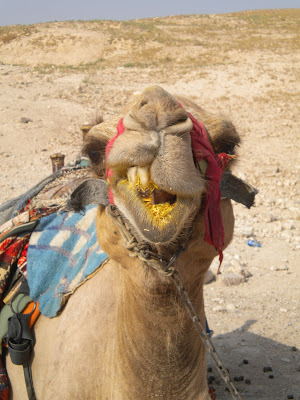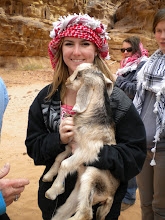“The Palestine Wildlife Society (PWLS) is a nongovernmental organization based in Beit Sahour that promotes migratory bird habitat conservation by engaging local youth and international tourists.
 In November 2009, the US Forest Service conducted field visits with the Palestine Wildlife Society to a number of the sites in the West Bank where the PWLS conducts recreation and conservation activities. The purpose of this visit was to explore opportunities for partnership, where Forest Service technical experience could contribute to the PWLS conservation efforts in the West Bank.
In November 2009, the US Forest Service conducted field visits with the Palestine Wildlife Society to a number of the sites in the West Bank where the PWLS conducts recreation and conservation activities. The purpose of this visit was to explore opportunities for partnership, where Forest Service technical experience could contribute to the PWLS conservation efforts in the West Bank.…The Forest Service works with partners throughout the Middle East to mange recreation activities that also promote environmental stewardship in protected areas and community managed landscapes. These activities can become popular destinations for the local population and tourists by providing access to and understanding of areas of natural beauty and/or cultural significance.
…From August 1-10th, 2010, a three-person USFS technical team will visit the West Bank to work with the PWLS and its partners on interpretive planning at sites where the PWLS conducts conservation activities. Basic interpretive planning can improve and inform every aspect of managing natural and cultural areas. As tourism increases and the PWLS continues education activities with local youth, an interpretive strategy will assist in deciding how to interpret and manage important sites in the West Bank.”
Today is only Friday and we still have a few more days of work left, but I am going to write about what we have done so far and put up lots of pictures from the sites we have been to. It has been an awesome week and I have been fortunate enough to travel all over the West Bank with the Wildlife Society staff. So far I have gained a lot of knowledge about the political and cultural aspects of Palestine, so it is really interesting learning from an environmental approach instead. Because of the current political conditions environmental issues have not been prioritized at all, but through the hard work of the PWLS as well as other NGOs and some GOs this is slowly changing.
The kickoff day was August 1st, last Sunday. I arrived at the PWLS office and was greeted outside the door by a large man wearing dark sunglasses and a secret-service style ear piece. In the driveway were two large black SUVs, and there was another one parked on the sidewalk down the road. With all the security I half expected President Obama to be inside when I walked in, but he wasn’t. The PWLS guys told me that security had come to the office about 20 minutes earlier and searched the entire thing, including the toilets. Shortly after the three Americans arrived (from Jerusalem, where they are staying, because it is too much of a ‘security risk’ to have US government officials stay in the West Bank): Chris from Washington D.C., Cheryl from Colorado, and Jennifer from Arizona. We all introduced ourselves and then talked in Imad’s office for a while. Imad is Jiries’ cousin and the brains behind the organization. He originally created it all by himself in 1999 and is the most passionate animal/environment lover I have ever met. He always has a million things going on at once and sometimes they don’t all get done but his personal background and general knowledge are very impressive.
The PWLS staff and the Americans talked in Imad’s office about stuff and things for a while until the other “stakeholders” showed up. This included representatives from the Palestinian Ministry of Agriculture, the Ministry of Tourism, the Ministry of Education, the Environmental Quality Authority, the Water Authority, and others.
 Each person gave a brief overview about what their job is, why they are interested in the conservation of some of Palestine’s natural resources, and why conservation education is important. Unfortunately at one point we lost electricity (it has been really unreliable for the past couple weeks) so we were unable to use the power point presentations most people had prepared. We had to wait before the electricity came back to eat lunch because it had to be heated up. It was a long, hot wait for almost an hour. All the fans and air conditioning were off, and it was easily over 105 degrees outside.
Each person gave a brief overview about what their job is, why they are interested in the conservation of some of Palestine’s natural resources, and why conservation education is important. Unfortunately at one point we lost electricity (it has been really unreliable for the past couple weeks) so we were unable to use the power point presentations most people had prepared. We had to wait before the electricity came back to eat lunch because it had to be heated up. It was a long, hot wait for almost an hour. All the fans and air conditioning were off, and it was easily over 105 degrees outside.After lunch the Americans (except for me, I don’t count) piled into one of the security vans and Imad and I hopped into his pickup truck. We drove for about 30 minutes and met them at Bani Naeem, which is an environmental education center pretty much in the middle of the desert. We went into the small building where lots of schools go for environmental field trips, and we talked to the people who work there about the importance of the area. They told us that during the spring all of the sand mountains are covered in vegetation, and thousands of people come out to picnic there at a time.
 For this reason they need more adequate facilities and maybe some sort of tourist-oriented things (like descriptive signs) to ensure a fulfilling experience. The teacher from the madrasa (which means “school” in Arabic) in Hebron that I went to with the PWLS a month or so ago was there, she seemed really happy to see me. We are friends on Facebook now, but I can’t understand anything she ever writes to me because it is in Arabic- I have to look it all up on Google translator. Anyways, it was insanely hot there. Everyone was fanning themselves with either paper, or a hat, or any nearby inanimate object. Despite the heat, the visit generated some really positive dialogue and I learned a lot about the area.
For this reason they need more adequate facilities and maybe some sort of tourist-oriented things (like descriptive signs) to ensure a fulfilling experience. The teacher from the madrasa (which means “school” in Arabic) in Hebron that I went to with the PWLS a month or so ago was there, she seemed really happy to see me. We are friends on Facebook now, but I can’t understand anything she ever writes to me because it is in Arabic- I have to look it all up on Google translator. Anyways, it was insanely hot there. Everyone was fanning themselves with either paper, or a hat, or any nearby inanimate object. Despite the heat, the visit generated some really positive dialogue and I learned a lot about the area. Bani Naeem!


Security hiding in the bushes:




On the way home Imad and I stopped for some fruits at a market.

Settlements dominated the landscape the whole way home:

The next day Imad picked me up at the painful hour of 7 a.m. and we took off for Wadi Quilt..
 We parked at a spot overlooking the Judean Desert, which is where Jesus wandered for 40 days and nights, according to the Bible.The Americans hadn’t arrived yet, so we spoke with a couple of Bedouin men for a few minutes. We gave them these little cushion things to give to their donkeys so that the bridle strap wouldn’t cut the donkeys’ snouts. The PWLS does a lot of work with donkeys in Bedouin communities. One guy asked me what my name was and when I told him he laughed and said his name was Ali. He let me sit on his camel for a few minutes, which was angry at first because Ali took away the food bag, but soon enough was smiling for the camera. I really love camels; I couldn’t help but wonder if he could tell I had camel meat for dinner the night before. I am wracked with guilt.
We parked at a spot overlooking the Judean Desert, which is where Jesus wandered for 40 days and nights, according to the Bible.The Americans hadn’t arrived yet, so we spoke with a couple of Bedouin men for a few minutes. We gave them these little cushion things to give to their donkeys so that the bridle strap wouldn’t cut the donkeys’ snouts. The PWLS does a lot of work with donkeys in Bedouin communities. One guy asked me what my name was and when I told him he laughed and said his name was Ali. He let me sit on his camel for a few minutes, which was angry at first because Ali took away the food bag, but soon enough was smiling for the camera. I really love camels; I couldn’t help but wonder if he could tell I had camel meat for dinner the night before. I am wracked with guilt. 








We drove down the desert slope on a rough trail until we reached the Wadi Quilt oasis, which is a small and beautiful patch of land. We admired the vegetation and talked about the educational value of the site. Some kids came down on donkeys to see what we were doing and Imad gave them some of the fluffy donkey snout things. It was so hot outside. We went back up to the lookout point to check out the desert landscape but we were soon evicted by a tour bus full of religious Italians who began to set up a full mass where we were sitting.

Ruins from a Jordanian military base:




We got back in the car and drove a little deeper into the desert until we reached the viewing place overlooking St. Jiries monastary, which is built into the rock wall of a large canyon.
The entrance:

The view:



Before leaving I sat on a donkey (just a photo op., no ride sadly)


More to come!


No comments:
Post a Comment